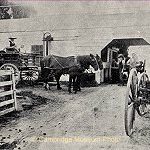Collections
Our Cambridge Collection has changing exhibitions about Cambridge. Much of our collection is in storage to ensure its preservation for future generations.
Cambridge Collections
Pukekura Dairy Factory

‘Times were hard in 1880s. Beef, mutton and dairy produce all alike were difficult to dispose of at anything like remunerative prices. But there came to farm near Hamilton a Mr [David] Gemmell from California and he started making butter as carried out in the United States on a somewhat improved system from that of the ordinary farmer. One day he invited Mr Henry Reynolds to take a pound of his butter and keep it in his cupboard for two months and at the end of that time he said it would be found “perfectly sweet and good”. Mr Reynolds did so. The boast was proved correct.
“Shortly afterwards,” stated Mr Reynolds, “Mr Gemmell told me he had decided to sell his farm and return to Los Angeles. It struck me that if butter of such quality could be turned out on a large scale and exported there should be something in it. This resulted in my asking Mr Gemmell if, after selling his farm, he would remain in the country for six months at a moderate remuneration and show us how to turn the article out on the factory system. To this he agreed and I erected [the] small factory at Pukekura and this was the commencement of making butter on the factory system in the Waikato.”
‘Henry Reynolds was up betimes on November 3, 1886. After an early meal and with the blessing of his wife who, valiant pioneer that she was, helped him so much in those days, he hastened from his home to the simple little factory erected a mile or so away. There he busied himself in preparation for the arrival of his neighbouring farmers with their morning’s milk. For this was the day when butter, and ‘Anchor’ butter at that, was to be made for the first time in New Zealand on the factory system.
‘With typical Cornish thoroughness – he and his brother Richard were Cornish farmers of moderate means who [twenty] years previously had taken up several blocks of land in the Waikato district – he had already had a trial run on the separator the previous evening with milk sledged from his father’s farm by a lad named Hicks.
‘The trial had been satisfactory so Mr Reynolds waited with equanimity for the dawn of the factory era. Whatever his thoughts, and great as was his belief in dairying we can be sure of this: that neither he nor those with him that day foresaw the change – the miracle – that half a century would bring through the activity he was then to start by churning in that little one-floored factory at Pukekura the first small total of less than 100lbs of ‘Anchor’ butter.’
(When considering a name for his butter Henry Reynolds noticed that one of his employees had an anchor tattooed on his arm and said, we will call our butter ‘Anchor’.)
‘So the great adventure started. The butter turned out in the small factory gave satisfaction to all who handled or ate it. Mr Gemmell operated the factory for the first season and was succeeded in September 1887 by Mr Archie McVicar.
Mr McVicar said, “We experienced many difficulties and drawbacks getting our machinery to run smoothly at first. We gained much knowledge by hard, practical experience. Danish separators were then used. The daily churnings in 1887 were about 100 lbs and we used the ‘Anchor’ brand print on them. The difficulty was to dispose of our butter and to secure a suitable package for transit. We used expensive boxes from Auckland called ‘Ponds’. These boxes were enamelled on the inside and cost 4/6d or more each. We also used large tins each holding 50 or 56 lbs. with about an inch of brine on top. Later on we used kegs. These large tins were sent to Cairns and Queensland Australia. Some of the butter in the smaller tins was sent to Hong Kong and China. The Home [British] market thought our packages were not suitable until finally the kegs were sent. In 1888 the ‘Anchor’ butter gained a Gold Medal at the Melbourne Exhibition.”
Mr McVicar made that butter.
(Ref: The NZ Co-Operative Dairy Co Ltd Jubilee Souvenir booklet ‘The Empire’s Dairy Farm’ – 1936)
